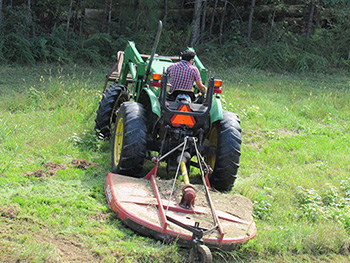Riparian Zones
Riparian Zones
Campus Riparian Zones Receive a Crew Cut
By Bill Willis
December 21, 2016

At one time, all the open space between roadways and woods was maintained as a three inch high lawn. Grooming extended into the woods to remove low limbs and understory species, all of which required a large commitment of funds, workforce, and time. NIEHS made a decision in the early 2000’s to allow the vegetation along the wood lines to grow naturally, creating a gradation between the mixed pine and hardwood forest and the manicured lawn. The gradation area is called a riparian buffer zone and helps protect the lake.
These ground maintenance activities provided for a more natural campus, noticeable savings, and a more diverse and enhanced landscape. Earlier this month, the riparian buffer zones received their yearly mowing.
Why have the riparian zone?
The vegetation stabilizes lake bank, slows storm-water runoff and intercepts sediments, nutrients and possible pollutants. From a financial perspective, these zones reduce the total acreage of lawn that requires constant upkeep. Leaving the vegetation undisturbed longer provides shelter, food and hiding places for various insects, reptiles, and rodents, increasing the overall wildlife diversity.
How was the zone created and maintained?
Initially, part of the area was plowed and sowed with a mixture of native grasses like Bluestem, Grama, and Indian grass and wildflowers like coreopsis, cosmos, and cornflower. These plants then reseeded themselves the second year without additional sowing. These grasses dominate all but the hardiest flowers, making the riparian zones predominately native grasses.
Why were they mowed at all?
Mowing opens the vegetation to more sun, water and air creating natural mulching. Without mowing, woody plants would soon appear and dominate, compromising integrity of the dam. Mowing once a year helps prevent this.
What is being done about invasive species?
A program is underway to combat exotics that are competing with the native grasses and wildflowers. Removing seed heads, cutting to the ground, and then plowing under are being employed for Johnson grass, lespedeza, and stilt grass. The State allows the removal of invasive plants in lake buffer zones.
What about wildflowers?
NIEHS has made a commitment to be a good environmental steward and to enhance the landscape for native plants, pollinators, and wildlife, when and wherever possible. With the with emphasis on pollinators, NIEHS will remain an active participant in educational and environmental programs through Wildlife and Industry Together and a Butterfly Highway designation. Wildflower plantings are part such efforts.



